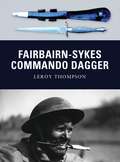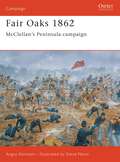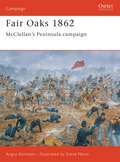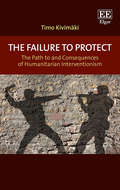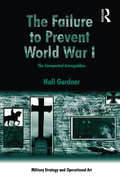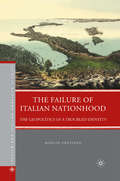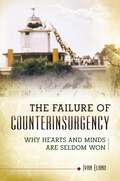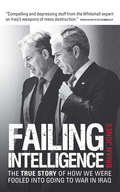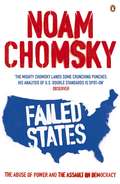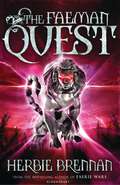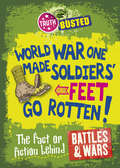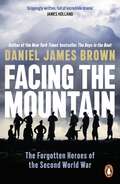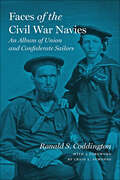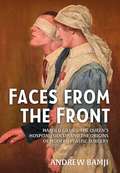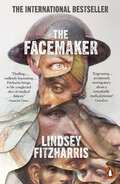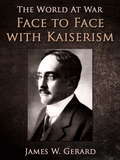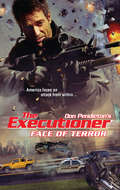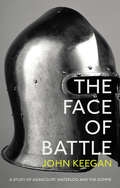- Table View
- List View
Fairbairn-Sykes Commando Dagger: The Complete Illustrated History Of The Fairbairn-sykes Fighting Knife (Weapon #7)
by Howard Gerrard Leroy ThompsonThe Fairbairn-Sykes Commando dagger has become iconic as the most widely recognized fighting knife in the world. The origins of the dagger can be traced to Shanghai in the 1930s where W. E. Fairbairn and US Marine officers including Sam Yeaton carried out experiments to develop what they considered the perfect knife for close combat. When Fairbairn and Sykes became instructors for the Commandos, they refined the design which would evolve into the classic Fairbairn-Sykes dagger. The dagger was first used during early Commando raids into occupied Europe but saw action in every theatre of World War II. US Rangers and Marines who had trained with the Commandos took their Fairbairn-Sykes daggers home, and this also influenced the development of American Special Forces daggers. The Fairbairn-Sykes remained in use with many units after the war. It has become a symbol of Commando and special forces units throughout the world.
Fair Oaks 1862: McClellan’s Peninsula campaign (Campaign)
by Angus KonstamFollowing its humiliating defeat at the First Battle of Bull Run, General George B. McClellan took command of the Union Army of the Potomac. In the spring of 1862, having rebuilt his forces, the "Little Napoleon" devised a plan to end the war in a single campaign. Transporting his army by sea to the Virginia Peninsula, he would outflank Confederate forces and march unopposed on Richmond, the Southern capital. Excessive caution squandered the opportunity, however, and on 31 May the Confederates struck at McClellan's divided forces at Fair Oaks. This book details McClellan's controversial Peninsula campaign and the southern attempt to halt the Union juggernaut.
Fair Oaks 1862: McClellan’s Peninsula campaign (Campaign)
by Angus KonstamFollowing its humiliating defeat at the First Battle of Bull Run, General George B. McClellan took command of the Union Army of the Potomac. In the spring of 1862, having rebuilt his forces, the "Little Napoleon" devised a plan to end the war in a single campaign. Transporting his army by sea to the Virginia Peninsula, he would outflank Confederate forces and march unopposed on Richmond, the Southern capital. Excessive caution squandered the opportunity, however, and on 31 May the Confederates struck at McClellan's divided forces at Fair Oaks. This book details McClellan's controversial Peninsula campaign and the southern attempt to halt the Union juggernaut.
Fair Juno (Mira Ser. #No. 13)
by Stephanie LaurensFrom the sparkling ballrooms of Regency London to the wealthy glamour of the country house – let Stephanie Laurens be your guide!
The Failure to Protect: The Path to and Consequences of Humanitarian Interventionism
by Timo KivimäkiThis book investigates the reasons behind, and consequences of, military operations by Western powers. It focuses on those humanitarian interventions aimed at protecting civilians from terror, dictators and criminals in fragile states. Contributing to the cosmopolitan, feminist and post-colonial literature on interventions, 12 case studies from across the globe are explored, including military interventions in: Afghanistan, the Central African Republic, Iraq, Kosovo, Libya, Mali, Mauritania, Pakistan, Sierra Leone, Somalia, Syria and Yemen. The interventionist era post 1999 has been associated with an increase in conflict fatalities, while the non-interventionist era 1989–1999 is associated with declining conflict violence. This book analyses both quantitatively and qualitatively the interactive discourses of the proponents and opponents of humanitarian protection. Timo Kivimäki explores the need for a representative global agency and legitimate institutions to avoid accusations of partisanship, and calls for the removal of the masculine gender bias in protection to create ‘democratic matriotism’. A timely read for advanced international relations scholars, this book analyses the data surrounding military interventions, providing a thorough insight into the last two decades of humanitarian conflict work. Politicians and practitioners of wartime humanitarian protection will also greatly benefit from this book.
The Failure to Prevent World War I: The Unexpected Armageddon (Military Strategy and Operational Art)
by Hall GardnerWorld War I represents one of the most studied, yet least understood, systemic conflicts in modern history. At the time, it was a major power war that was largely unexpected. This book refines and expands points made in the author’s earlier work on the failure to prevent World War I. It provides an alternative viewpoint to the thesis of Christopher Clark, Fritz Fischer, Paul Kennedy, among others, as to the war's long-term origins. By starting its analysis with the causes and consequences of the 1870-71 Franco-Prussian War and the German annexation of Alsace-Lorraine, the study systematically explores the key geostrategic, political-economic and socio-cultural-ideological disputes between France, Germany, Austria-Hungary, Italy, Russia, Japan, the United States and Great Britain, the nature of their foreign policy goals, alliance formations, arms rivalries, as well as the dynamics of the diplomatic process, so as to better explain the deeper roots of the 'Great War'. The book concludes with a discussion of the war's relevance and the diplomatic failure to forge a possible Anglo-German-French alliance, while pointing out how it took a second world war to realize Victor Hugo’s nineteenth-century vision of a United States of Europe-a vision now being challenged by financial crisis and Russia's annexation of Crimea.
The Failure to Prevent World War I: The Unexpected Armageddon (Military Strategy and Operational Art)
by Hall GardnerWorld War I represents one of the most studied, yet least understood, systemic conflicts in modern history. At the time, it was a major power war that was largely unexpected. This book refines and expands points made in the author’s earlier work on the failure to prevent World War I. It provides an alternative viewpoint to the thesis of Christopher Clark, Fritz Fischer, Paul Kennedy, among others, as to the war's long-term origins. By starting its analysis with the causes and consequences of the 1870-71 Franco-Prussian War and the German annexation of Alsace-Lorraine, the study systematically explores the key geostrategic, political-economic and socio-cultural-ideological disputes between France, Germany, Austria-Hungary, Italy, Russia, Japan, the United States and Great Britain, the nature of their foreign policy goals, alliance formations, arms rivalries, as well as the dynamics of the diplomatic process, so as to better explain the deeper roots of the 'Great War'. The book concludes with a discussion of the war's relevance and the diplomatic failure to forge a possible Anglo-German-French alliance, while pointing out how it took a second world war to realize Victor Hugo’s nineteenth-century vision of a United States of Europe-a vision now being challenged by financial crisis and Russia's annexation of Crimea.
The Failure of Italian Nationhood: The Geopolitics of a Troubled Identity (Italian and Italian American Studies)
by M. GrazianoThis book explains Italy s endless political instability and its historical, cultural and economic roots. It also illustrates why, even after the creation of the Italian state, Italy was never really unified. Piero Gobetti described fascism once as the "autobiography" of the Italian nation. This book explains why today it is possible to describe "berlusconism" - a cultural, political and social phenomenon in Italy- as the most recent version of this country s autobiography.
The Failure of Counterinsurgency: Why Hearts and Minds Are Seldom Won (Praeger Security International)
by Ivan ElandThis book examines the implications of counterinsurgency warfare for U.S. defense policy and makes the compelling argument that the United States' default position on counterinsurgency wars should be to avoid them.Given the unsatisfactory outcomes of the counterinsurgency (COIN) wars in Afghanistan and Iraq, the U.S. military is now in a heated debate over whether wars involving COIN operations are worth fighting. This book provides a comprehensive analysis of the effectiveness of COIN through key historic episodes and concludes that the answer is an emphatic "no," based on a dominant record of U.S. military or political failure, and inconsistency in the reasons for the rare cases of success. The author also examines the implications of his findings for U.S. foreign policy, defense policy, and future weapons procurement.
The Failure of Counterinsurgency: Why Hearts and Minds Are Seldom Won (Praeger Security International)
by Ivan ElandThis book examines the implications of counterinsurgency warfare for U.S. defense policy and makes the compelling argument that the United States' default position on counterinsurgency wars should be to avoid them.Given the unsatisfactory outcomes of the counterinsurgency (COIN) wars in Afghanistan and Iraq, the U.S. military is now in a heated debate over whether wars involving COIN operations are worth fighting. This book provides a comprehensive analysis of the effectiveness of COIN through key historic episodes and concludes that the answer is an emphatic "no," based on a dominant record of U.S. military or political failure, and inconsistency in the reasons for the rare cases of success. The author also examines the implications of his findings for U.S. foreign policy, defense policy, and future weapons procurement.
Failing Intelligence: How Blair Led Us into War in Iraq
by Brian JonesThis is the first book on Iraq by a British intelligence official involved in the process that led to Britain taking part in the 2003 invasion. As the former head of the UK Defence Intelligence Staff's nuclear, biological and chemical section, Brian Jones is ideally placed to pronounce upon the way in which Britain was taken to war and the way in which the intelligence reporting on Iraq's weapons of mass destruction (WMD) was manipulated to justify Saddam Hussein's removal from power. Jones calls on his own experience and knowledge, a variety of leaked documents, and the expert testimony given to a series of inquiries, including the current Chilcot inquiry, to examine how and why Tony Blair and George W. Bush, managed to deceive their legislatures and their electorates into believing that Iraqi WMD was a real threat that could attack the West within 45 minutes. He describes how Blair and Bush sought to use subsequent inquiries to cover up their own culpability in the deception, in order to facilitate re-election and keep their jobs. In conclusion, Jones pulls together the lessons that should have been learned in relation to both the use of intelligence to justify policy-making and with regard to broader international issues of security and governance.
Failed States: The Abuse of Power and the Assault on Democracy (American Empire Project Ser.)
by Noam ChomskyThe United States asserts the right to use military force against ‘failed states’ around the globe. But as Noam Chomsky argues in this devastating analysis, America shares features with many of the regimes it insists are failing and constitute a danger to their neighbours. Offering a comprehensive and radical examination of America past and present, Chomsky shows how this lone superpower – which topples foreign governments, invades states that threaten its interests and imposes sanctions on regimes it opposes – has stretched its own democratic institutions to breaking point. And how an America in crisis places the world ever closer to the brink of nuclear and environmental disaster.
The Faeman Quest (Faerie Wars Chronicles)
by Herbie BrennanIn the exciting conclusion to Herbie Brennan's New York Times bestselling Faerie Wars series, a child who is half faerie, half human has the power to determine the fate of both worlds.The Faeman Girl is Mella, daughter of Lord Henry and Queen Holly Blue, half faerie, half human and all trouble. When Mella accidentally travels to the country of Haleklind, she discovers rebel forces preparing an invasion using magical manticores. Old favourites are here - Brimstone, Lord Hairstreak and Pyrgus - but readers will identify immediately with Mella, whose stubborn streak and feisty daring must save the faerie realm from mass destruction.
The Fact or Fiction Behind Battles and Wars: The Fact Or Fiction Behind Battles And Wars (Truth or Busted #12)
by Kay BarnhamTruth or Busted's battles and wars title explores popular myths and legends about some of the world's most famous conflicts in a tongue-in-cheek, humorous way that kids will find unputdownable! Alongside features such as 'Battle Blunders' in which we learn about people or countries that have lost battles or wars for bizarre reasons, Truth or Busted statements such as 'Ancient Greek armies were square' or 'Elephants are excellent warriors' are explored. We look at where the idea came from, whether it has any basis in truth, or whether they can be consigned to folklore. Finally, each statement is given a TRUTH or BUSTED evaluation! A must for anyone interested in battles and wars, or studying history at school!
Facing the Catastrophe: Jews and Non-Jews in Europe during World War II (Occupation in Europe)
by Beate Kosmala Georgi VerbeeckCovering Western and Eastern Europe, this book looks at the Holocaust on the local level. It compares and contrasts the behaviour and attitude of neighbours in the face of the Holocaust. Topics covered include deportation programmes, relations between Jews and Gentiles, violence against Jews, perceptions of Jewish persecution, and reports of the Holocaust in the Jewish and non-Jewish press.
Facing the Catastrophe: Jews and Non-Jews in Europe during World War II (Occupation in Europe)
by Beate Kosmala Georgi VerbeeckCovering Western and Eastern Europe, this book looks at the Holocaust on the local level. It compares and contrasts the behaviour and attitude of neighbours in the face of the Holocaust. Topics covered include deportation programmes, relations between Jews and Gentiles, violence against Jews, perceptions of Jewish persecution, and reports of the Holocaust in the Jewish and non-Jewish press.
Facing The Mountain: The Forgotten Heroes of the Second World War
by Daniel James BrownFrom the #1 New York Times bestselling author of The Boys in the Boat comes the gripping untold story of one of the most heroic units that fought in World War II'My favourite kind of history book: grippingly written, full of incredible drama, and focussing on individuals rather than numbers and statistics' James HollandOn December 7th 1941, the Japanese Navy bombed Pearl Harbor. For many Americans, the surprise attack was a call to arms - but for the soldier sons of Japanese-American immigrant parents, it brought prejudice and scrutiny over where their loyalties lay.In Facing the Mountain, Daniel James Brown tells the unforgettable story of the 442nd Regimental Combat Team, the Japanese-American heroes who displayed incredible courage on the brutal battlefields of Europe. Achieving the impossible in often near-suicidal missions, including rescuing a 'lost battalion' surrounded by Nazis in the French mountains, the 442nd went on to become one of the most decorated units in history. Yet at the same time, their parents were put in camps and stripped of their livelihoods, and an equally brave battle was being fought in the courtroom back home. A cinematic tour de force, Facing the Mountain puts a real-life band of brothers in the history books where they belong and reminds us that victory is rarely as simple as we think.
Facing Down the Soviet Union: Britain, the USA, NATO and Nuclear Weapons, 1976-1983
by Kristan StoddartFacing Down the Soviet Union reveals for the first time the historic deliberations regarding the Chevaline upgrade to Britain's Polaris force, the decisions to procure the Trident C-4 and then D-5 system from the Americans in 1980 and 1982. It also details the decision to base Ground Launched Cruise Missiles in the UK in 1983.
Faces of the Civil War Navies: An Album of Union and Confederate Sailors
by Ronald S. CoddingtonDuring the American Civil War, more than one hundred thousand men fought on ships at sea or on one of America;€™s great inland rivers. There were no large-scale fleet engagements, yet the navies, particularly the Union Navy, did much to define the character of the war and affect its length. The first hostile shots roared from rebel artillery at Charleston Harbor. Along the Mississippi River and other inland waterways across the South, Union gunboats were often the first to arrive in deadly enemy territory. In the Gulf of Mexico and along the Atlantic seaboard, blockaders in blue floated within earshot of gray garrisons that guarded vital ports. And on the open seas, rebel raiders wreaked havoc on civilian shipping. In Faces of the Civil War Navies, renowned researcher and Civil War photograph collector Ronald S. Coddington focuses his considerable skills on the Union and Confederate navies. Using identifiable cartes de visite of common sailors on both sides of the war, many of them never before published, Coddington uncovers the personal histories of each individual who looked into the eye of the primitive camera. These unique narratives are drawn from military and pension records, letters, diaries, period newspapers, and other primary sources. In addition to presenting the personal stories of seventy-seven intrepid volunteers, Coddington also focuses on the momentous naval events that ushered in an era of ironclad ships and other technical innovations. The fourth volume in Coddington;€™s series on Civil War soldiers, this microhistory will appeal to anyone with an interest in the Civil War, social history, or photography. The narratives and photographs in Faces of the Civil War Navies shed new light on a lesser-known part of our American story. Taken collectively, these "snapshots" remind us that the history of war is not merely a chronicle of campaigns won and lost, it is the collective personal odysseys of thousands of individual life stories.
Faces of the Civil War Navies: An Album of Union and Confederate Sailors
by Ronald S. CoddingtonDuring the American Civil War, more than one hundred thousand men fought on ships at sea or on one of America;€™s great inland rivers. There were no large-scale fleet engagements, yet the navies, particularly the Union Navy, did much to define the character of the war and affect its length. The first hostile shots roared from rebel artillery at Charleston Harbor. Along the Mississippi River and other inland waterways across the South, Union gunboats were often the first to arrive in deadly enemy territory. In the Gulf of Mexico and along the Atlantic seaboard, blockaders in blue floated within earshot of gray garrisons that guarded vital ports. And on the open seas, rebel raiders wreaked havoc on civilian shipping. In Faces of the Civil War Navies, renowned researcher and Civil War photograph collector Ronald S. Coddington focuses his considerable skills on the Union and Confederate navies. Using identifiable cartes de visite of common sailors on both sides of the war, many of them never before published, Coddington uncovers the personal histories of each individual who looked into the eye of the primitive camera. These unique narratives are drawn from military and pension records, letters, diaries, period newspapers, and other primary sources. In addition to presenting the personal stories of seventy-seven intrepid volunteers, Coddington also focuses on the momentous naval events that ushered in an era of ironclad ships and other technical innovations. The fourth volume in Coddington;€™s series on Civil War soldiers, this microhistory will appeal to anyone with an interest in the Civil War, social history, or photography. The narratives and photographs in Faces of the Civil War Navies shed new light on a lesser-known part of our American story. Taken collectively, these "snapshots" remind us that the history of war is not merely a chronicle of campaigns won and lost, it is the collective personal odysseys of thousands of individual life stories.
Faces From The Front: Harold Gillies, The Queen's Hospital, Sidcup And The Origins Of Modern Plastic Surgery (PDF)
by Andrew BamjiFaces from the Front examines the British response to the huge number of soldiers who incurred facial injuries during the First World War. These injuries were produced within a short time span, but (for the first time in a major conflict) did not necessarily lead to death due to developments in anaesthesia and improvements in the treatment of infection and blood loss. Casualties were evacuated back to England, where surgeons had an opportunity to develop their skills on a large patient caseload. Harold Gillies, an ambitious young surgeon, developed a new branch of surgery: plastic surgery of the face. The book argues that the development and refinement of new surgical techniques was helped by a multi-disciplinary approach. Detailed patient records - combined with notes, photographs and paintings - were used to evaluate the efficacy of experimental procedures and to educate new surgeons. Treatment often involved multiple operations and took place over long periods of time, and considerable thought was given to the recovery and rehabilitation of patients. The Queen's Hospital had two important legacies: first, it played a pivotal role in the development of modern medical practice by paving the way for a new surgical specialty - plastic surgery - and by showcasing the benefits of specialist hospitals and multi-disciplinary services; second, the reconstruction of damaged faces had a major impact on the patients themselves. Drawing on a unique collection of personal and family accounts of the post-war lives of patients treated at Sidcup, the author explores surgical and aesthetic outcomes and the emotional impact of facial reconstruction.
The Facemaker: One Surgeon's Battle to Mend the Disfigured Soldiers of World War I
by Lindsey FitzharrisThe poignant story of the visionary surgeon who rebuilt the faces of the First World War's injured heroes, and in the process ushered in the modern era of plastic surgeryFrom the moment the first machine gun rang out over the Western Front, one thing was clear: mankind's military technology had wildly surpassed its medical capabilities. The war's new weaponry, from tanks to shrapnel, enabled slaughter on an industrial scale, and given the nature of trench warfare, thousands of soldiers sustained facial injuries. Medical advances meant that more survived their wounds than ever before, yet disfigured soldiers did not receive the hero's welcome they deserved.In The Facemaker, award-winning historian Lindsey Fitzharris tells the astonishing story of the pioneering plastic surgeon Harold Gillies, who dedicated himself to restoring the faces - and the identities - of a brutalized generation. Gillies, a Cambridge-educated New Zealander, became interested in the nascent field of plastic surgery after encountering the human wreckage on the front. Returning to Britain, he established one of the world's first hospitals dedicated entirely to facial reconstruction in Sidcup, south-east England. There, Gillies assembled a unique group of doctors, nurses and artists whose task was to recreate what had been torn apart. At a time when losing a limb made a soldier a hero, but losing a face made him a monster to a society largely intolerant of disfigurement, Gillies restored not just the faces of the wounded but also their spirits. Meticulously researched and grippingly told, The Facemaker places Gillies's ingenious surgical innovations alongside the poignant stories of soldiers whose lives were wrecked and repaired. The result is a vivid account of how medicine and art can merge, and of what courage and imagination can accomplish in the presence of relentless horror.
Face to Face with Kaiserism (The World At War)
by James GerardJames Watson Gerard (August 25, 1867 – September 6, 1951) was a United States lawyer and diplomat. At the outbreak of World War I in 1914, Gerard assumed the care of British interests in Germany, later visiting the camps where British prisoners were confined and doing much to alleviate their condition. His responsibilities were further increased by the fact that German interests in France, Great Britain, and Russia were placed in the care of the American embassies in those countries, the American embassy in Berlin thus becoming a sort of clearing house. From first-hand knowledge he was able to settle the question, much disputed among the Germans themselves, as to the official attitude of the German government toward the violation of Belgian neutrality. Gerard published two books on his experiences, titled “My Four Years in Germany”, released in 1917 and the following year, “Face to Face with Kaiserism”. (Excerpt from Wikipedia)
Face Of Terror
by Don PendletonA cadre of violent bank robbers is wreaking havoc in the midwestern states, amassing a small fortune and a large body count. Covered faces, jungle fatigues and foreign accents have everyone–from their victims to the government–thinking an Arab terror cell is to blame.
The Face Of Battle: A Study of Agincourt, Waterloo and the Somme (Playaway Adult Nonfiction Ser.)
by John KeeganThe Face of Battle is military history from the battlefield: an imperishable account of the direct experience of individuals at 'the point of maximum danger'. It examines the physical conditions of fighting, the particular emotions and behaviour generated by battle, as well as the motives that impel soldiers to stand and fight rather than run away. In this stunningly vivid reassessment of three battles, John Keegan conveys their reality for the participants, whether facing the arrow cloud of Agincourt, the levelled muskets of Waterloo or the steel rain of the Somme.
